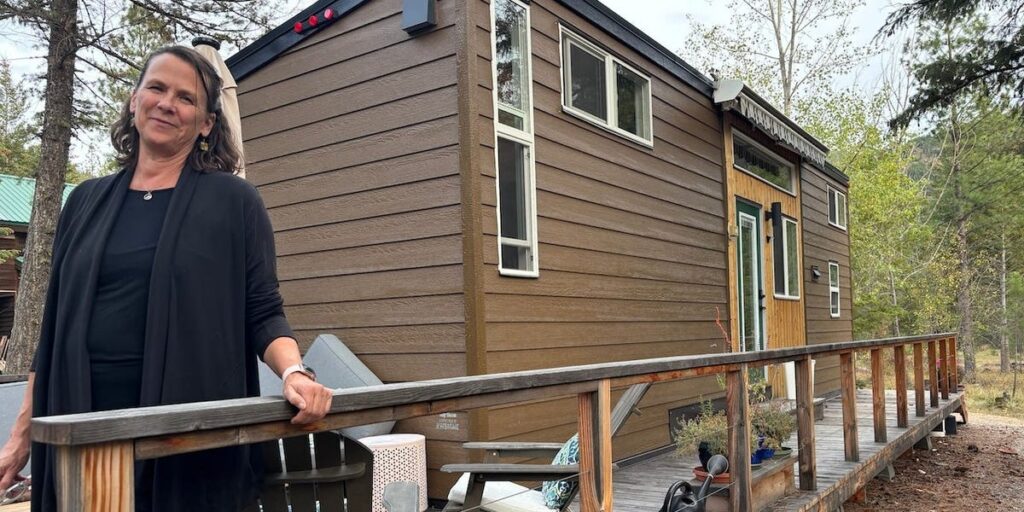When Emilie Karas bought an old, rundown house on a quarter-acre residential lot in Portland, Oregon, in early 2020, she never expected to replace it with four homes that would house nine people.
That’s because, as Karas was in the middle of rebuilding her new house, the city legalized up to two backyard cottages, or, in housing policy speak, “accessory dwelling units” (ADU) on residential lots with an existing home. But then the city went even further, allowing each lot to also house an RV or other mobile home for full-time habitation.
Karas quickly jumped on the opportunity and built two ADUs stacked on top of each other, like a duplex, in her backyard. But she didn’t stop there. She also bought and installed a furnished, pre-fabricated “tiny home on wheels” — a pocket-sized moveable house on an 8-by-24-foot trailer.
Tiny homes on wheels (THOWs) are a hybrid of a camper and a backyard cottage. If their wheels are concealed, you might mistake one for a regular tiny home, but they’re constructed on a trailer chassis and can be moved.
They’re “a smaller, cuter version of a typical American house,” said Kol Peterson, a Portland-based tiny home advocate and contractor. But they’re legally considered vehicles, meaning they aren’t subject to the often burdensome regulations permanent homes are. Amid a nationwide shortage in housing, they could be a new option for people looking for an affordable starter home, if more places follow in Portland’s footsteps.
“There are all these philosophical elements to it, such as the ability to have freedom of mobility, and not have a mortgage, and downsizing and living simply, having a small ecological footprint,” Peterson said. “But I think underlying all that is just the sheer economics of it and the fact that these are the only attainable housing type for a lot of Americans.”
Karas’ tiny home on wheels was much easier and cheaper to add to her property than her ADUs. The difference was “night and day,” she said.
The process of building the ADUs was similar to constructing a normal home — they needed an expensive foundation, and were subject to a slew of building and zoning codes. Because THOWs are considered vehicles by most jurisdictions, including Portland, the city doesn’t require them to be certified or inspected, and they aren’t subject to local infrastructure fees. She paid about $60,000 to buy the fully-furnished THOW and have it delivered from Florida, where it was manufactured. And she spent another few thousand dollars having it installed on her property.
For the last two years, Karas has rented out her THOW and two ADUs and lives in the main house with her partner and three roommates. She charges $1,200 a month, including utilities, for the THOW.
“It creates an even more affordable option for folks who maybe are lower income to have a really safe, beautiful home,” Karas, 38, said of her THOW. “They have to live in community with other people, but we have a really great vibe.”
In most places outside Portland and designated RV parks, it isn’t legal to live in tiny homes on wheels full-time. By recognizing THOWs as permanent housing, Portland is “fostering a very radical, inexpensive housing type to exist legally within this otherwise extremely regulated industry that has nothing but very expensive homes,” Peterson said.
A cheaper starter home
Like RVs, THOWs can be built entirely in a factory, don’t require a permanent foundation, and are mobile. They can also be designed to operate off-grid, without access to an outside water, electricity, or sewer system.
But what really sets them apart from other stand-alone homes is their low price point. Peterson estimated that most THOW owners spend between $50,000 and $150,000 to purchase and install their unit, which typically includes hooking it up to water, electricity, and a sewer line. ADUs, by contrast, typically cost between $100,000 and $300,000 to build, not including the cost and time required to obtain permits.
“The cost advantage is so enormous and the housing shortage is so substantial that you can totally see a lot of homeowners be like, ‘I cannot afford to build a backyard cottage — I had it priced out and the bid came back at $350,000 — but I could totally afford to put in a tiny home on wheels,'” said Alan Durning, executive director of the Seattle-based progressive think tank Sightline Institute.
But the vast majority of jurisdictions in the US have restrictions on living in THOWs or other structures classified as vehicles.
“Most people who want to buy our product we cannot sell to,” said Jonathan Palley, the CEO of a California-based THOW and ADU builder called Clever Tiny Homes. “Not because they can’t afford it, not because it wouldn’t be great for them, but because you cannot put it on that land.”
Of course, tiny houses on wheels are just one solution to a vast and complex nationwide housing shortage. Cities need to focus on legalizing and building denser housing, like new apartment buildings, especially in commercial and transit corridors, said Jenny Schuetz, vice president of housing at Arnold Ventures. Schuetz also expects THOWs will have a harder time taking off in wealthier places that have traditionally opposed new and denser housing construction.
“I’d be shocked if the snooty Boston and Connecticut suburbs allow tiny homes on wheels anywhere,” Schuetz said.
Despite the restrictions and local pushback, Jen McCarthy, founder of Teacup Tiny Homes, a Canadian THOW builder, says she’s seen growing interest in her homes, which were particularly popular during the pandemic years. Over the last couple of years, she’s had more older customers looking to downsize or add a home to their property for their relatives.
“It’s not just a cool millennial thing anymore,” McCarthy said. “We’re starting to see that maybe the baby boomers or the Gen Xers are seeing how important it can be to house the people that they care for.”
Julie Lennox, 59, is one such customer. The Montana resident has lived in her Teacup THOW on her aging parents’ 15-acre property near Missoula for the last three years. After selling her house a few years ago, she wanted a more affordable home that she’d be able to move off her parents’ property or resell in the future.
“I’m now almost 60, and have no mortgage, and I’m able to be close to my parents and help them out,” said Lennox, who’s the head of a local private school. “It turned out to be a good decision.”
THOW advocates say they’re a better investment and offer a higher quality of living than traditional RVs. THOWs are mobile — they most often towed by a pick-up truck — but they’re not designed to hit the road as often as RVs do. This means they’re made with many of the same materials you’d use to build a regular house, while RVs are made with lighter-weight, travel-friendly materials like plastic.
Some THOW manufacturers help their clients navigate local regulations with creative products. Clever Tiny Homes manufactures both permanent and mobile tiny homes, including THOWs that can later be converted into ADUs on permanent foundations. Palley is working with a few customers who lost their homes earlier this year in the Eaton fire in Altadena, California, where local authorities are allowing residents to live in a mobile home on their property for a few years. These customers could resell their THOWs when the emergency rule expires, or they could install them as permanent backyard homes, Palley said.
“You can get it immediately as an RV because it’s easy to permit, and then you can install it later as a permanent structure, because it’s certified as modular construction as well,” he said.
Manufacturers and other advocates for THOWs are bullish that they could offer millions of people a more affordable type of starter home or retirement housing. Peterson, Durning, and other housing advocates in the Pacific Northwest are now pushing to legalize them at the state level in Oregon and Washington.
Durning called THOW legalization the next frontier in the push for more affordable starter homes and infill development.
“The leading edge is the ADU market fully developing in most places,” he said. “And the bleeding edge is the tiny homes on wheels.”
Read the full article here
















